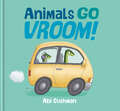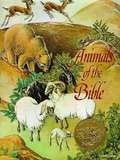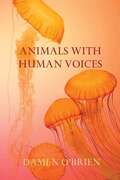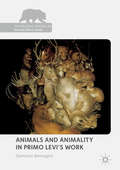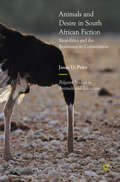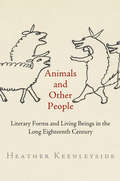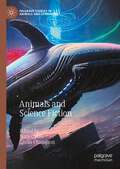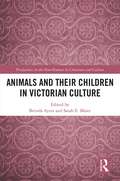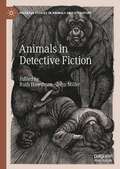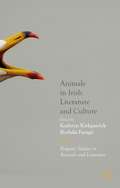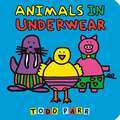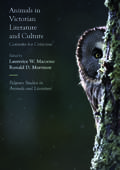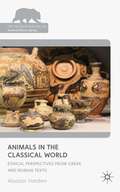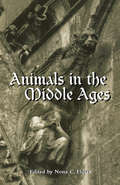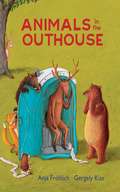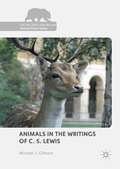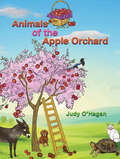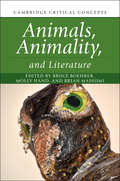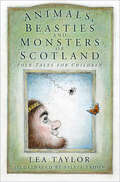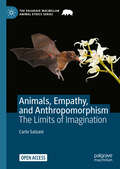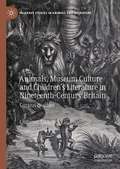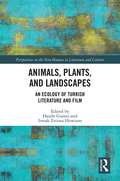- Table View
- List View
Animals Go Vroom!
by Abi CushmanWith a nod to Richard Scarry, this inventive picture book surprises readers with every turn of the page!Hiss! Screech! Roar! It's a noisy day in Bumperville! But are the sounds what you think they are? That Honk! must surely be a goose. But turn the page and it's the taxi that a goose is driving! Using cleverly placed die-cuts, this inventive book hints at what is making the sound, but with each turn of the page, it's an eye-opening surprise and part of an unfolding story that is part guessing game and part giggle-inducing caper. Abi Cushman is the master of surprise and silliness in this absolutely delightful picture book.
Animals Of The Bible
by Dorothy P. Lathrop Helen D. FishDorothy Lathrop's Animals of the Bible won the very first Caldecott Medal when it was originally published in 1937. Now, in honor of the sixtieth anniversary of this prestigious medal and its first recipient, comes this special deluxe edition of Lathrop's award-winning collection of some of the Bible's most extraordinary animals. Thirty richly detailed black-and-white drawings illustrate the favorite stories of the Creation, Noah's Ark, the first Christmas, and many others. A glorious tribute to a great tradition in children's literature, this special anniversary edition will be a keepsake to treasure for years to come.
Animals With Human Voices
by Damen O'BrienIn Animals with Human Voices you will find worms that dream of god, jellyfish weary of immortality, a powerless Superman, some illogical observations on aliens', a lightning conductor tired of lightning and the truth about Elvis. In multi award-winning poet Damen O'Brien's debut collection, his cinematic eye and love of nature deliver poems which are ciphers for the normal concerns of every human: love, life and death and what we leave behind.
Animals and Animality in Primo Levi’s Work (The Palgrave Macmillan Animal Ethics Series)
by Damiano BenvegnùSituated at the intersection of animal studies and literary theory, this book explores the remarkable and subtly pervasive web of animal imagery, metaphors, and concepts in the work of the Jewish-Italian writer, chemist, and Holocaust survivor Primo Levi (1919-1987). Relatively unexamined by scholars, the complex and extensive animal imagery Levi employed in his literary works offers new insights into the aesthetical and ethical function of testimony, as well as an original perspective on contemporary debates surrounding human-animal relationships and posthumanism. The three main sections that compose the book mirror Levi’s approach to non-human animals and animality: from an unquestionable bio-ethical origin (“Suffering”); through an investigation of the relationships between writing, technology, and animality (“Techne”); to a creative intellectual project in which literary animals both counterbalance the inevitable suffering of all creatures, and suggest a transformative image of interspecific community (“Creation”).
Animals and Desire in South African Fiction: Biopolitics and the Resistance to Colonization (Palgrave Studies in Animals and Literature)
by Jason D. PriceThis book considers the political potential of affective experiences of desire as reflected in contemporary South African literature. Jason Price argues that definitions of desire deployed by capitalist and colonial culture maintain social inequality by managing relations to ensure a steady flow of capital and pleasure for the dominant classes, whereas affective encounters with animals reveal the nonhuman nature of desire, a biopower that, in its unpredictability, can frustrate regimes of management and control. Price wonders how animals' different desires might enable new modes of thought to positively transform and resist the status quo. This book contends that South African literary works employ nonhuman desire and certain indigenous notions of desire to imagine a South Africa that can be markedly different from the past.
Animals and Other People: Literary Forms and Living Beings in the Long Eighteenth Century
by Heather KeenleysideIn Animals and Other People, Heather Keenleyside argues for the central role of literary modes of knowledge in apprehending animal life. Keenleyside focuses on writers who populate their poetry, novels, and children's stories with conspicuously figurative animals, experiment with conventional genres like the beast fable, and write the "lives" of mice as well as men. From such writers—including James Thomson, Daniel Defoe, Jonathan Swift, Laurence Sterne, Anna Letitia Barbauld, and others—she recovers a key insight about the representation of living beings: when we think and write about animals, we are never in the territory of strictly literal description, relying solely on the evidence of our senses. Indeed, any description of animals involves personification of a sort, if we understand personification not as a rhetorical ornament but as a fundamental part of our descriptive and conceptual repertoire, essential for distinguishing living beings from things.Throughout the book, animals are characterized by a distinctive mode of agency and generality; they are at once moving and being moved, at once individual beings and generic or species figures (every cat is also "The Cat"). Animals thus become figures with which to think about key philosophical questions about the nature of human agency and of social and political community. They also come into view as potential participants in that community, as one sort of "people" among others. Demonstrating the centrality of animals to an eighteenth-century literary and philosophical tradition, Animals and Other People also argues for the importance of this tradition to current discussions of what life is and how we might live together.
Animals and Science Fiction (Palgrave Studies in Animals and Literature)
by Giulia Champion Nora CastleAnimals and Science Fiction is the first edited collection to be published focusing on the intersection of animal studies and science fiction studies. It offers a broad range of theoretical approaches and primary source texts—including novels, short stories, poetry, film and TV, photography, erotica, video games, and urban planning documents—that explore the ways works of science fiction can transform how we see and interact with nonhuman others. With an eye toward more just multispecies futures, it argues that speculative imaginaries can be pivotal in changing attitudes toward and understandings of nonhuman animals in our world today. Chapters appeal to those interested in biopolitics, posthumanism, new materialism, ecocriticism and the environmental humanities, ocean humanities, postcolonial studies, critical race studies, Indigenous studies, global sf studies, film studies, and food studies. Taken together, the collection works to showcase a diverse and growing field ofscholarly inquiry into animals and science fiction.
Animals and Their Children in Victorian Culture (Perspectives on the Non-Human in Literature and Culture)
by Brenda Ayres Sarah Elizabeth MaierWhether a secularized morality, biblical worldview, or unstated set of mores, the Victorian period can and always will be distinguished from those before and after for its pervasive sense of the "proper way" of thinking, speaking, doing, and acting. Animals in literature taught Victorian children how to be behave. If you are a postmodern posthumanist, you might argue, "But the animals in literature did not write their own accounts." Animal characters may be the creations of writers’ imagination, but animals did and do exist in their own right, as did and do humans. The original essays in Animals and Their Children in Victorian explore the representation of animals in children’s literature by resisting an anthropomorphized perception of them. Instead of focusing on the domestication of animals, this book analyzes how animals in literature "civilize" children, teaching them how to get along with fellow creatures—both human and nonhuman.
Animals in Detective Fiction (Palgrave Studies in Animals and Literature)
by John Miller Ruth HawthornThis book explores the vast array of animals that populate detective fiction. If the genre begins, as is widely supposed, with Edgar Allan Poe’s “Murders in the Rue Morgue” (1841), then detective fiction’s very first culprit is an animal. Animals, moreover, consistently appear as victims, clues, and companions, while the abstract conception of animality is closely tied to the idea of criminality. Although it is often described as an essentially conservative form, detective fiction can unsettle the binary of human and animal to intersect with developing concerns in animal studies: animal agency, the ethical complexities of human/animal interaction, the politics and literary aesthetics of violence, and animal metaphor. Gathering its 14 essays into sections on ontologies, ethics, politics, and forms, Animals in Detective Fiction provides a compelling and nuanced analysis of the central role creatures play in this enduringly popular and continually morphing literary form.
Animals in Irish Literature and Culture
by Kathryn Kirkpatrick Borbála FaragóAnimals in Irish Literature and Culture spans the early modern period to the present, and includes essays exploring some of Ireland's better known animals—birds, horses, pigs, cows, and dogs—as well as its less considered animals—hares, foxes, eels, and insects. The collection also unsettles the boundaries and definitions of 'nation' by exploring colonial, post-colonial, and globalized manifestations of Ireland as country and state as well as the human animal and non-humananimal migrations that challenge a variety of literal and cultural borders. In essays addressing a range of Irish cultural production, contributors consider the impacts of conceptual categories of nature, animality, and humanness on actual human and animal lives. Emerging in the era of the sixth mass extinction, brought on by human-induced climate change and habitat destruction, this volume aims to make a contribution to eco-critical thought and practice in Irish Studies and beyond.
Animals in Underwear ABC
by Todd ParrFrom alligator to zebra - with a goldfish, iguana, yak, and even a unicorn in between - there's no better way to learn the alphabet than with animals... in underwear! Todd Parr's signature kid-friendly illustrations and bold colors showcase an array of animals in all kinds of hilarious underwear styles, making learning the alphabet tons of fun. Featuring a padded cover and gate folds on every spread, here's a playful, silly way for kids to learn their ABCs!
Animals in Victorian Literature and Culture: Contexts for Criticism (Palgrave Studies in Animals and Literature)
by Laurence W. Mazzeno Ronald D. MorrisonThis collection includes twelve provocative essays from a diverse group of international scholars, who utilize a range of interdisciplinary approaches to analyze "real" and "representational" animals that stand out as culturally significant to Victorian literature and culture. Essays focus on a wide range of canonical and non-canonical Victorian writers, including Charles Dickens, Anthony Trollope, Anna Sewell, Emily Bronte, James Thomson, Christina Rossetti, and Richard Marsh, and they focus on a diverse array of forms: fiction, poetry, journalism, and letters. These essays consider a wide range of cultural attitudes and literary treatments of animals in the Victorian Age, including the development of the animal protection movement, the importation of animals from the expanding Empire, the acclimatization of British animals in other countries, and the problems associated with increasing pet ownership. The collection also includes an Introduction co-written by the editors and Suggestions for Further Study, and will prove of interest to scholars and students across the multiple disciplines which comprise Animal Studies.
Animals in the City (Fountas & Pinnell Classroom, Guided Reading Grade 1)
by Joanne Friar Jacqueline AdamsNIMAC-sourced textbook
Animals in the Classical World
by Alastair HardenThis sourcebook presents nearly 200 specially-translated Greek and Roman texts from Homer to Plutarch, revealing the place of the animal in the moral consciousness of the Classical era. Philosophical, historical, dramatic and poetic texts explore how animals were regarded in all aspects of ancient life, from philosophy to farming.
Animals in the Middle Ages: A Book Of Essays (Routledge Medieval Casebooks #Vol. 13)
by Nona C. FloresThese interdisciplinary essays focus on animals as symbols, ideas, or images in medieval art and literature.
Animals in the Outhouse
by Gergely Kiss Anja FrohlichOne morning all of the animals in the forest awake to discover an intruder in their midst! It's a bright blue outhouse, installed by the park ranger who is tired of the forest smelling nasty and his dog walking in stinky animal poop! From now on, the animals must do their business in the outhouse. Dr. Grunter the boar, Billy the bear, Harriet the hare, Prickly the hedgehog, Fancy the fox, Antony the stag, and Olive the owl all do their very best to use this strange and unnatural device. But was the outhouse really such a good idea? Mishap ensues as each animal tries to impress the others by pooping in the plastic, portable potty. Animals in the Outhouse shows children it is never worth doing something you are uncomfortable with just for the sake of fitting in. Children will love this silly story that is also a lesson about conformity.
Animals in the Writings of C. S. Lewis (The Palgrave Macmillan Animal Ethics Series)
by Michael J. GilmourThis book examines C. S. Lewis's writings about animals, and the theological bases of his opposition to vivisection and other cruelties. It argues Genesis is central to many of these ethical musings and the book's organization reflects this. It treats in turn Lewis's creative approaches to the Garden of Eden, humanity's "dominion" over the earth, and the loss of paradise with all the catastrophic consequences for animals it presaged. The book closes looking at Lewis's vision of a more inclusive community. Though he left no comprehensive summary of his ideas, the Narnia adventures and science fiction trilogy, scattered poems and his popular theology inspire affection and sympathy for the nonhuman. This study challenges scholars to reassess Lewis as not only a literary critic and children's author but also an animal theologian of consequence, though there is much here for all fans of Mr. Bultitude and Reepicheep to explore.
Animals of the Apple Orchard
by Judy O'HaganBobbin the mouse was a wonderful storyteller. Each day, the animals would gather under the gnarly old oak tree in the orchard. It was a huge tree with twisted roots which provided excellent seats for the animals, (once Puss the cat had stitched some plump feather cushions, that is). The tree soon became known as the ‘make-believe’ tree thanks to Bobbin’s mystical tales, and the animals looked forward to his daily stories. All in all, life in the wintry apple orchard was very good indeed. That is, until one exceptionally cold morning, when the animals noticed that Cedric the tortoise was missing. Find out what happens next!
Animals on Board: Adding, Level 2 (MathStart #1)
by Stuart J. Murphy<p>Ride along with trucker Jill and her dog as they add up the animals zooming by. But these are no ordinary animals, and they're bound for a surprise destination! <p>Ride along with trucker Jill and her dog as they add up the animals passing by on other trucks. But these are no ordinary animals, and theyre bound for a surprise destination! Lively illustrations by R.W. Alley make adding truckloads of fun.</p>
Animals, Animality, and Literature (Cambridge Critical Concepts)
by Brian Massumi Bruce Boehrer Molly HandAnimals, Animality, and Literature offers readers a one-volume survey of the field of literary animal studies in both its theoretical and applied dimensions. Focusing on English literary history, with scrupulous attention to the interplay between English and foreign influences, this collection gathers together the work of nineteen internationally noted specialists in this growing discipline. Offering discussion of English literary works from Beowulf to Virginia Woolf and beyond, this book explores the ways human/animal difference has been historically activated within the literary context: in devotional works, in philosophical and zoological treatises, in plays and poems and novels, and more recently within emerging narrative genres such as cinema and animation. With an introductory overview of the historical development of animal studies and afterword looking to the field's future possibilities, Animals, Animality, and Literature provides a wide-ranging survey of where this discipline currently stands.
Animals, Beasties and Monsters of Scotland: Folk Tales for Children
by Lea Taylor Sylvia TroonWhat do you think happened when Jack refused to do his chores? Do you think you’re clever enough to hide from Dundee’s dragon? Watch out for Lefty the spider dying to tell you his story about life in the glen … The stories in this book are of animals, beasties and monsters that are fast and cunning and scary and big. And they are ready to tell their tales to you …
Animals, Empathy, and Anthropomorphism: The Limits of Imagination (The Palgrave Macmillan Animal Ethics Series)
by Carlo SalzaniThis open access book explores the role of imagination in animal ethics and its constitutive links to empathy/sympathy and anthropomorphism. The book argues for the constitutive role of imagination in ethical deliberation, but acknowledges that there exist important limits to its use. However, &“limit&” is here understood not merely negatively as restriction and insufficiency, but rather positively as &“condition of possibility,&” so what the book explores and analyses are the conditions for a positive and fruitful use of the imagination in ethics. The book uses as a &“frame&” the questions and issues raised in J.M. Coetzee&’s The Lives of Animals to explore some central and salient themes.
Animals, Museum Culture and Children’s Literature in Nineteenth-Century Britain: Curious Beasties (Palgrave Studies in Animals and Literature)
by Laurence TalairachAnimals, Museum Culture and Children’s Literature in Nineteenth-Century Britain: Curious Beasties explores the relationship between the zoological and palaeontological specimens brought back from around the world in the long nineteenth century—be they alive, stuffed or fossilised—and the development of children’s literature at this time. Children’s literature emerged as dizzying numbers of new species flooded into Britain with scientific expeditions, from giraffes and hippopotami to kangaroos, wombats, platypuses or sloths. As the book argues, late Georgian, Victorian and Edwardian children’s writers took part in the urge for mass education and presented the world and its curious creatures to children, often borrowing from their museum culture and its objects to map out that world. This original exploration illuminates how children’s literature dealt with the new ordering of the world, offering a unique viewpoint on the construction of science in the long nineteenth century.
Animals, Plants, and Landscapes: An Ecology of Turkish Literature and Film (Perspectives on the Non-Human in Literature and Culture)
by Hande Gurses Irmak Ertuna HowisonThe landscape of Turkey, with its trees and animals inspires narratives of survival, struggle and escape. Animals, Plants, and Landscapes: An Ecology of Turkish Literature and Film, will be the first major study to offer fresh theoretical insight into this landscape, by offering a collection of analyses of key texts of Turkish literature and cinema. Through discussion of both classical and contemporary works, this volume, paves the way for the formation of a ecocritical canon in Turkish literature and the rise of certain themes that are unique to Turkish experience. Snakes, fishermen and fish who catch men, porcupines contemplating on human agency, dogs exiled on an island and men who put dogs to fights, goat herders and windy steppes of Anatolia are all agents in a territory that constantly shifts. The essays included in this volume demonstrate the ways in which the crystallized relations between human and non-human form, break, and transform.

